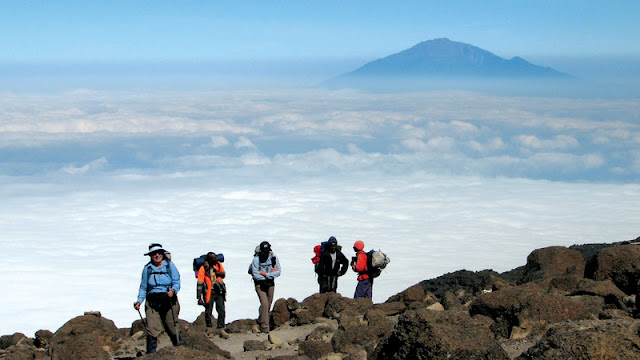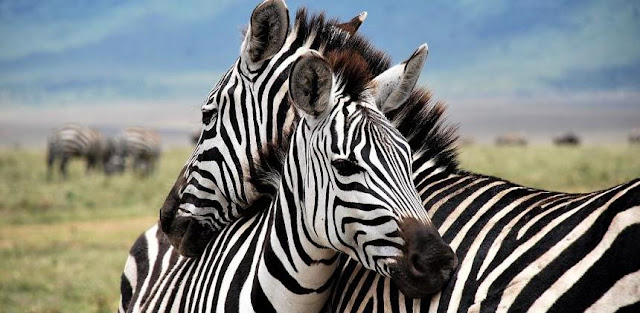KILI QUESTIONS AND ANSWERS
FREQUENTLY ASKED QUESTIONS
1. HOW DO I GET TO THE MOUNTAIN?
The mountain has it’s own airport (Kilimanjaro International Airport, IATA airport code JRO). Currently around seven airlines fly into JRO, including KLM, Kenya Airways, Turkish Airlines, Ethiopian, Qatar Airways, Flydubai (partners with Emirates) and Rwandair. Your trekking company will then transfer you to a hotel in Moshi or Arusha, and from there (usually the next day) will take you to the mountain to begin your trek. (If you arrive without booking your trek, then a taxi from the airport to Moshi/Arusha is US$50.)You can also arrive overland, of course, with the mountain town of Arusha connected by bus to Kampala in Uganda and Nairobi in Kenya, as well as Tanzania’s largest city, Dar es Salaam (from where buses travel to/from other neighbouring countries).2. How many people climb each year?The latest figures that have been released by the park authorities show that, in 2016, there were 47,232 people who tried to climb Africa’s Highest Mountain. The table below summarises how the visitor numbers have changed since we wrote the first edition of the book back in 2001: Kilimanjaro visitor numbers
| Year | No of climbers on Kilimanjaro |
|---|---|
| 2001 | 21,025 |
| 2004 | 34,530 |
| 2007 | 40,701 |
| 2012 | 57,456 |
| 2016 | 47,232 |
3. HOW MANY PEOPLE GET TO THE SUMMIT EACH YEAR?
The percentage of people getting to the summit varies according to the route, the duration of the climb and the trekking company that they used. But we reckon that, as a rough guide, about 75% of people make it to the summit. Some companies claim a summiting success rate well above 90%, and for some routes that may be true. It’s worth noting, however, that KINAPA, the park authorities, reckon that actually only 65% of people make it to the summit, with about a third more making it to the Crater Rim. (Uhuru Peak, the highest point on the mountain, is the highest point on the rim of the crater, but you actually reach the rim at Stella Point or Gillman’s Point, which are slightly lower, and about 45 minutes/90 minutes away from Uhuru Peak respectively).We, however, are sceptical about these figures from KINAPA. Fo a start, they also say that less than 1% (0.53% to be precise) fail to get to the Crater rim, which just seems ludicrously low, as anyone who has been on the mountain, and has seen people being taken off the mountain without reaching the rim, can testify. We also know that some unscrupulous guides and companies will tell KINAPA that someone got to the top even when they didn’t, in order to:a) boost their ‘success rates’, which look good when it comes to advertising their climbs;and b) secure a certificate for their client saying they got to the top, which may persuade the client to give a bigger tip at the end of the trek and to leave a more positive review online as well.So while KINAPA may be the park authorities, we think that their statistics for people reaching the summit are anything but ‘authoritative’.
4. HOW MANY PEOPLE DIE EVERY YEAR?
We estimate that there are approximately 6-7 deaths every year on Kili. Figures are never released by the authorities for fear of the bad publicity they will generate. But extrapolating from the only academic study done on this subject, we estimate that there are about half a dozen deaths per annum. Note that this is only the number of ‘tourists’ who die on the mountain; in addition to this, we reckon that about the name number of porters and other mountain crew die on the mountain each year too.
5. WHAT ANIMALS LIVE ON THE MOUNTAIN?
There’s plenty of wildlife on the mountain, though your chances of seeing much are slim. This is largely because the animals prefer to avoid those parts of the mountain where more than 45,000-plus people tread every year. For this reason, you’ll be lucky to see anything larger than a monkey or a mouse. That said, every so often a reader will write in to say that they saw a buffalo, eland, leopard or elephant on the trail.
6. CAN ANYONE CLIMB?
You need to be at least ten years old to climb Kili. (Incidentally, there are huge discounts on the park fees for under 16s – amounting, for example, to over US$700 for a six-day Machame trek. Make sure these are passed onto you. Many companies don’t pass on all of the discount. If you want to know how much your discount should be, just contact us.) That said, there are currently one six-year-old and three seven-year-olds who have climbed to the summit – all of whom needed special permission from KINAPA. At the other extreme, there is no upper-age limit, and the oldest person ever to make it was 88 when he made it to the top.
7. HOW DIFFICULT IS IT TO CLIMB TO THE TOP?
The first and most important thing I need to say on this matter is as follows:All the main routes up the mountain are really just walking routesI really need to emphasise this point: you do not need any technical climbing or mountaineering skills to get to the summit. So you don’t need to be a mountaineer. Sure, there are a couple of places on some routes where you may need to use your hands to steady yourself. Occasionally you may also need to haul yourself over a rock or two. But overall, it’s just a walk. Indeed, there are a couple of people who’ve climbed up the mountain in wheelchairs, so the ability to walk isn’t even a pre-requisite. Blind climbers have felt their way to the top and amputee victims have hobbled and crawled up to the top.And don’t be worried about the (negligible) amount of scrambling (ie, using your hands to haul yourself up) that you need to do either. I am not in any way a technical climber. I am a bit of a wimp too, if I’m being honest. But I’ve climbed the mountain over 30 times now, on every route. With no problems. It’s all straightforward. And if you’re with a half-decent company, there will always be a guide around to help you if you’re having difficulty.Even the walking is not particularly exhausting. After all, just do the maths. For example, the most popular route is the Machame Route, which is 60.76km (37.75 miles) in length in total from gate to summit and back to gate. Do it in six days and that’s only a fraction over 10km per day (ie just over 6 miles); do it in seven days and it’s only around just 8.5km per day (a little under 5.5 miles per day).
8. HOW LONG DOES IT TAKE TO CLIMB?
The minimum number of days is five. The park authorities won’t allow you on any of the routes for fewer days than this. The Marangu Route, Machame, Rongai and Umbwe routes all can be done in just five days. That said, many agencies will not sell you a trek for five days as it doesn’t really give you enough time to acclimatise safely. We don’t recommend you take just five days either – it is simply too dangerous. At the other extreme some groups trek for 9-10 days – particularly those that go via the Northern Circuit. Most treks, however, are 6-8 days in length.The Golden Rule to remember is this: the longer you spend on the mountain, the greater your chances of getting to the summit.
9. WHO WAS THE FIRST PERSON TO REACH THE SUMMIT?
The first person to reach the summit is believed to be Hans Meyer, a geology professor from Leipzig in Germany, who climbed with his friend Ludwig Purtscheller and reached the summit on October 6th, 1889. It was Meyer’s fourth attempt to reach the top; however, it should also be mentioned that Meyer did not begin his walk on the mountain, as today’s visitors do, but in Mombasa, a 14-day walk away.
10. HOW HIGH IS KILIMANJARO?
The most widely accepted figure for the height of Africa’s Highest Mountain is 5895m (19,341ft). This is the figure you will find printed on the certificates handed out to those who successfully reach the summit, Uhuru Peak. Surprisingly, however, there is significant evidence to say it’s wrong. In 1999 a team of specialists from Karlsruhe University in Germany, using GPS technology, revised it down to 5892.55m (19,332.5ft). And in 2008 a team of 19 boffins from 6 countries, using GPS and gravimetric observations, revised it down still further, to 5890.79m (19,326/5ft). But let’s stick with the original of 5895m. That’s the figure that the cartographers of the Ordnance Survey came up with when they surveyed the mountain in the 1950s, and has been the accepted figure ever since.Incidentally, the mountain does have two other main peaks. Mawenzi, the ‘second summit’, is 5149m high (16,893ft); while the third ‘summit, Shira Ridge, is 3962m high (12,999ft).
11. WHY IS THE MOUNTAIN SO FAMOUS?
The mountain’s main claim to fame is that it is the highest Mountain in Africa. For that reason, it is often called the Roof of Africa. This also means it is one of the so-called Seven Summits – the highest mountains on each of the seven continents. It is also said to be the highest free-standing mountain in the world. In other words, it’s not part of a mountain range but stands all by itself in the heart of the East African plains. It is also one of the world’s highest ‘walkable’ mountains, where no technical climbing skills are required to reach the summit.
12. WHERE IS IT?
Africa’s highest mountain is in northern Tanzania, right against the border with Kenya, in East Africa. Don’t make the mistake, as many people do, of thinking it’s in Kenya. It’s not: it is wholly within Tanzania. Though it’s an easy error to make. After all, some of the best photos of the mountain were taken from a vantage point in Kenya’s Amboseli National Park. (I’m thinking in particular of those images of the mountain with elephants in the foreground.) The Kenyan Tourist Board is not above putting pictures of the mountain in its brochures either – a practice which infuriates the Tanzanians.I’ve even read a children’s book about a well-travelled koala bear called Bingo that places Africa’s highest mountain in Kenya. But suffice to say, it isn’t. So don’t fly to Kenya’s capital, Nairobi, and expect to climb the mountain from there; if you do, you’ll just have to buy yourself an onward flight or take a 6-8 hour bus ride to take you across the border into Tanzania. (That said, fly into Tanzania’s main airport, Dar es Salaam, and you’ll find yourself even further away from the mountain than if you flew into Nairobi – a bus from Dar to Moshi or Arusha, the two main towns at the foot of the mountain , takes pretty much the whole day, leaving around 6am and arriving late afternoon in Moshi or at dusk in Arusha.)Which does, of course, then beg the question: What airport should you fly into….



Comments